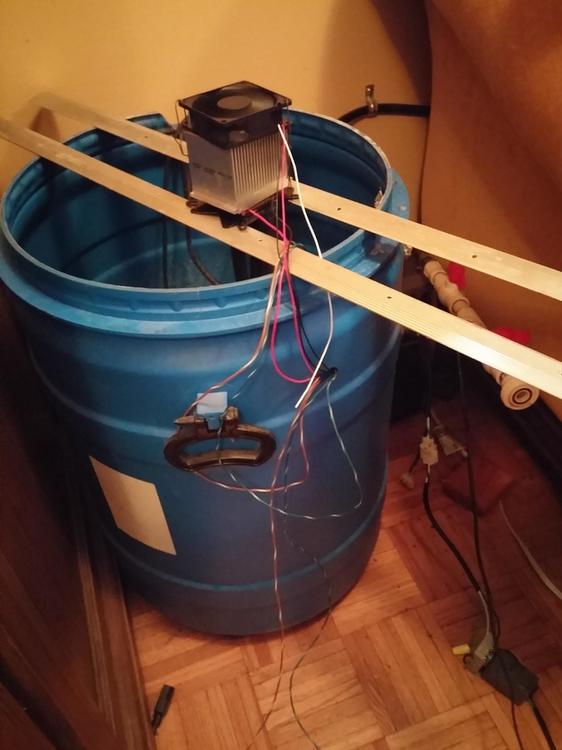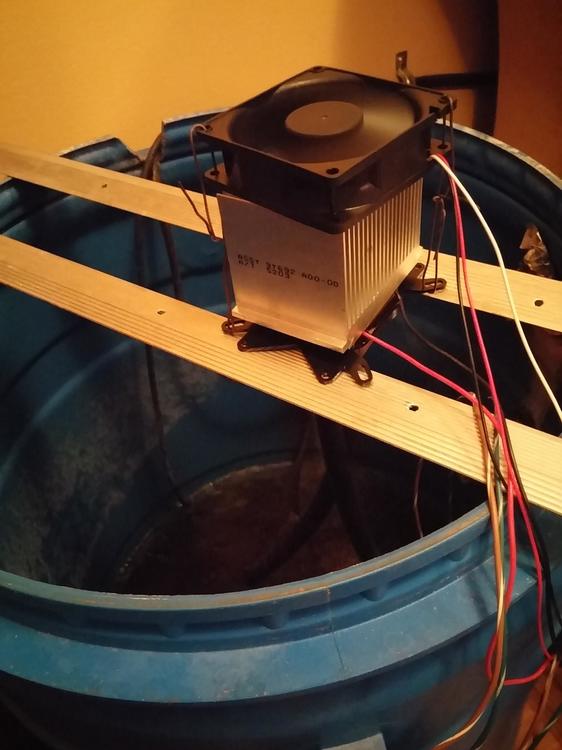
KennethT
participating member-
Posts
6,941 -
Joined
-
Last visited
Content Type
Profiles
Forums
Store
Help Articles
Everything posted by KennethT
-
Love Bon Marche for windowshopping, but very expensive. Glad to see the US so well represented... haha...
-
I think they just started up recently - I had never heard of them until I saw her giving her "demo" in Kalustyan's. It's a small jar that Kalustyan's sells for I think 6.99 - maybe 5.99 - somewhere around there... But it seems to be good for at least 4-5 meals - I've used it twice and I'm a little less than halfway through it. Also, as a NYer, you may be aware that Kalustyan's doesn't really give bargains on many things other than their core spices/rice, etc...
-
@Franci wow... That looks great. I would love it! Once the wrapper is opened, how long does it last?
-
Speaking of pepper, lately I've become a huge fan of Vietnamese peppercorns - NYers are fortunate to be able to get it at Kalustyan's (and maybe other places?) but I'm sure most people have never heard of it. I also found at Kalustyan's a good Malaysian curry paste, made in Long Island City, called Mama Lam's... the owner (a young Malaysian American woman) was there doling out a little bit on rice from a rice cooker... it was really tasty, and caused me to do what I normally don't and do an impulse buy.... it wasn't cheap though.
-
Is that really 1kg of chanterelles for 10Euro? Crazy!
-
Interesting... I don't quite understand the purpose of the handle though... also, at the bottom of the Amazon page are "similar items" that shows me 3 other circulators from brands I've never heard of... Wancle, Supreme.... one is $80, and another is $85 including shipping...
-
Chef John Besh resigns after 25 women claim sexual harassment
KennethT replied to a topic in Restaurant Life
I really hope that other people who do this type of stuff are watching and are getting very very nervous. Maybe it will be the force to get them to change their (and their employees') attitudes. -
What if the cookie was coated in cocoa butter or a thin layer of chocolate to act as a moisture barrier?
-
Many many years ago, I had made molded chocolates with a flowing marshmallow fluff-like center. I made the fluff from scratch using sugar/glucose, water, powdered egg whites and some vanilla... no gelatin. Worked quite well and was very tasty. It was a little tricky in the beginning to add the fluff to the mold, but pretty soon had no issues.
-
The thing I saw wasn't just a grow log - it was a whole system that looked like a 6 foot high bookshelf - it had a controller than controlled the whole environment - lights, humidity, temperature, etc...
-
I can't find it now, but somewhere on my Hydroponic forums I visit, someone advertised an indoor mushroom growing system - supposedly some restaurants in NYC are using them to grow their own mushrooms that they can harvest as needed.
-
@Thanks for the Crepes 1 Watt of electricity powering any light source will create 3.4 BTU per hour. What makes LEDs cooler is that you get more light per Watt (as measured by PPFD) than other sources, so depending on what you're growing and how much light you need, you could use less wattage. Keep in mind that normal incandescent bulbs should not be used in greenhouses as A) their color temperature is all wrong for plants and B) they put out very little light (PPFD wise). For many years, greenhouses have either used metal halide or sodium vapor lamps for supplemental lighting. They have a much higher light/watt output than incandescents. The problem is that the bulbs do create quite a bit of heat which will heat your greenhouse and will use quite a bit of power, both for the lights and any additional cooling you might need because of them.. Also, the bulbs light output decreases over time, so you should really change out your bulbs every 6 months as while they're still functioning, they're only putting out maybe 70% of what they initially did - and those bulbs are not cheap. LEDs are much more efficient than either of the above, and do not reduce output over time, and last much longer (usually about 10 years for a properly designed fixture with good heatsinks) but have a much higher initial cost - so it usually takes a few years to get your ROI.
-
Sorry - I didn't mean to say to actually use a bread proofing box - I just meant that it was like a bread proofing box - warm and humid. A bread proof box's controller is not usually very precise - you can make something much better either doing what you said, or using an Arduino and a temp/humidity sensor. That gives more flexibility than the aquarium controller since you can then adjust temp and humidity separately as needed.
-
@liuzhou I had always wondered about steaming fish with aromatics on the plate next to it. Does the aroma/flavor of the chilis get into the fish, or do they just get cooked alongside for the purpose of being eaten with the fish?
-
Most seeds require warmth to germinate... so the pros use something like a bread proofing box - it's usually a tall rack to allow multiple trays, with a reservoir of water and a submersible heater. You can make a controller to keep the internal temp around 90F and like 90 percent humidty - that way, all your seeds tend to sprout all at once. Peltier's work ok, but they are very inefficient. If I was to use a compressor based chiller to chill my reservoir, I would get better chilling using less power.
-
People do use liquid cooled systems to couple with the hot side of the peltier. Rather than trying to stick the hot side of the peltier to a pot of water, it would be better to attach it to a water block and then pump water through it - I think the mechanics of trying to sit the pot of water on the small peltier device would be, umm... challenging. But it also adds a ton of complexity, and for now, the heatsink that I harvested from an old computer is free and works just fine. For posterity, or anyone insane like me who might be considering doing something like this, keep in mind that silicone grease is not great for heat transfer - it's better to use thermal CPU heatsink grease, which has a very high thermal conductivity rating.
-
Meet the newest addition to the Space Garden: This is the reservoir - it's basically a food grade 35 gallon barrel. I've been experimenting making a reservoir chiller - since it basically sits in the middle of my living room, it's hard to keep the liquid temperature at the optimal range - about 65F - otherwise I'd have to keep it rather chilly in here... Proper professional res. chillers cost about $400 and are basically a 1/8-1/4HP refrigeration compressor that chills water or nutrient flowing through it using a pump. I wanted to spend quite a bit less money than that if possible, so the thing I have rigged up is a 12V 6A peltier module with a copper waterblock, heatsink and high speed computer fan. I have a small 12V pump sitting in the reservoir that pumps nutrient up to the copper waterblock to chill and then back into the res. Right now, this system is able to reduce the temp of my 9 gallon nutrient to about 67F in an ambient temp. of about 76 degF. I've been experimenting with it the last week or so to test its viability.... I'm pretty happy with it, so this weekend (hopefully) I'll integrate the module into the barrel's cover rather than suspending it over the top like I've been doing. I just didn't want to cut a hole in the cover if it didn't work well.
-
I've see this too, in Beijing, Vietnam and Thailand. The first few times I experienced it it drove me crazy - I felt like I was under the gun to make my choices as the server stood there anxiously waiting for me to so something. It was even funnier when in Beijing and I used the Waygo translation app to translate the menus into Pinyin and English - you had to scan each line and then wait a second for the response to come up... Doing this on a menu with about 100 lines was hilarious. Now, I try to learn how to say "please come back in a few minutes" to give me time to peruse before the standoff... which sometimes does and sometimes does not work... In Vietnam, I learned to say "I'm not ready" and then it's easy enough to flag them down later by saying "em, oi!!!" really loudly to get their attention...
-
Chocdoc - Checking out Chocolate in Belgium
KennethT replied to a topic in Food Traditions & Culture
Thanks for all this! Excited for Paris! -
Where are you? I didn't think it was still mangosteen season...
-
Braising in a hotter oven brings no advantage because the braising liquid can't get hotter than 212F. When covered, the steam inside can't get hotter than 212F either since the only way you can get hotter than that is under pressure. The speed of reaction that tenderizes tough meats (collagen turns to gelatin) varies depending on both time and temperature. The higher the temp, the faster it goes. But, as btbyrd said, in the pressure cooker, you get no evaporation, so the braising liquid won't thicken that way - you have to thicken it either before or after the fact. As for why oven braising tastes better - I'm not sure why that is, other than something simple like some things just take time - time for flavors to get extracted, mingle, etc...
-
Chocdoc - Checking out Chocolate in Belgium
KennethT replied to a topic in Food Traditions & Culture
Can I be the first to say, don't get saucy with me, bernaise! -
Basil needs more light or it will get leggy. But it doesn't need nearly as much light as a fruiting plant would need.
-
Re: Pretzels - I wonder if you could put the lye solution in a spray bottle and spritz them, rather than trying to dip/submerge? Re: banh mi - the ones I've seen in Vietnam did go stale very quickly... so much so, that in fact, the bakeries are hyper hyper local - only delivering within a very small radius. And most popular sellers get several deliveries per day to make sure of absolute freshness.
-
I'm curious if the book mentions specialty breads such as Vietnamese banh-mi, or the Singaporean bread used for bread-toast.




